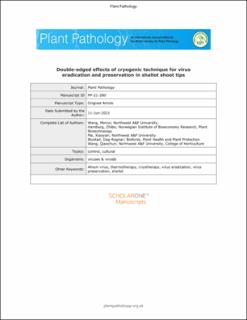| dc.contributor.author | Wang, Min-Rui | |
| dc.contributor.author | Hamborg, Zhibo | |
| dc.contributor.author | Ma, Xiao-Yan | |
| dc.contributor.author | Blystad, Dag-Ragnar | |
| dc.contributor.author | Wang, Qiaochun | |
| dc.date.accessioned | 2022-03-03T11:48:43Z | |
| dc.date.available | 2022-03-03T11:48:43Z | |
| dc.date.created | 2022-01-05T11:25:29Z | |
| dc.date.issued | 2021-09-04 | |
| dc.identifier.citation | Plant Pathology. 2021, . | en_US |
| dc.identifier.issn | 0032-0862 | |
| dc.identifier.uri | https://hdl.handle.net/11250/2982789 | |
| dc.description | This is the pre-peer reviewed version of the following article: Wang, M., Hamborg, Z., Ma, X., Blystad, D., & Wang, Q. (2021). Double‐edged effects of the cryogenic technique for virus eradication and preservation in shallot shoot tips. Plant Pathology, 71(2), 494–504. Portico, which has been published in final form at https://doi.org/10.1111/ppa.13466. This article may be used for non-commercial purposes in accordance with Wiley Terms and Conditions for Use of Self-Archived Versions." | en_US |
| dc.description.abstract | Plant virus eradication is a prerequisite for the use of virus-free propagules for sustainable crop production. In contrast, virus preservation is required for all types of applied and basic research of viruses. Shoot tip cryopreservation can act as a double-edged strategy, facilitating either virus eradication or virus preservation in cryoderived plants. Here, we tested the efficacies of shoot tip cryopreservation for virus eradication and preservation in shallot (Allium cepa var. aggregatum). In vitro stock shallot shoots infected with onion yellow dwarf virus (OYDV) and shallot latent virus were thermotreated for 0, 2, and 4 weeks at a constant temperature of 36℃ before shoot tip cryopreservation. Results showed that viruses were preserved in recovered shoots when thermotherapy was not applied. Although thermotherapy lowered the regrowth levels of cryotreated shoot tips, the efficiency of virus eradication increased from 5% to 54%. Immunolocalization of OYDV and histological observation of cryotreated shoot tips showed the high frequency of virus preservation was due to the viral invasion of cells close to the apical meristem and the high proportion of cells surviving. Four weeks of thermotherapy drastically decreased the distribution of OYDV, as well as the percentage of surviving cells within the shoot tips, thereby promoting virus eradication. Virus-free plants obtained from combining thermotherapy with cryotherapy showed significantly improved vegetative growth and bulb production. The present study reports how thermotherapy can act as a trigger to facilitate either the safe preservation of Allium viruses or the production of virus-free shallot plants. | en_US |
| dc.language.iso | eng | en_US |
| dc.publisher | John Wiley & Sons Ltd. | en_US |
| dc.title | Double-edged effects of the cryogenic technique for virus eradication and preservation in shallot shoot tips | en_US |
| dc.type | Peer reviewed | en_US |
| dc.type | Journal article | en_US |
| dc.description.version | submittedVersion | en_US |
| dc.rights.holder | © 2021 British Society for Plant Pathology | en_US |
| dc.source.pagenumber | 494-504 | en_US |
| dc.source.volume | 71 | en_US |
| dc.source.journal | Plant Pathology | en_US |
| dc.source.issue | 2 | en_US |
| dc.identifier.doi | 10.1111/ppa.13466 | |
| dc.identifier.cristin | 1975003 | |
| dc.relation.project | Norges forskningsråd: 255032 | en_US |
| cristin.ispublished | true | |
| cristin.fulltext | preprint | |
| cristin.qualitycode | 2 | |
